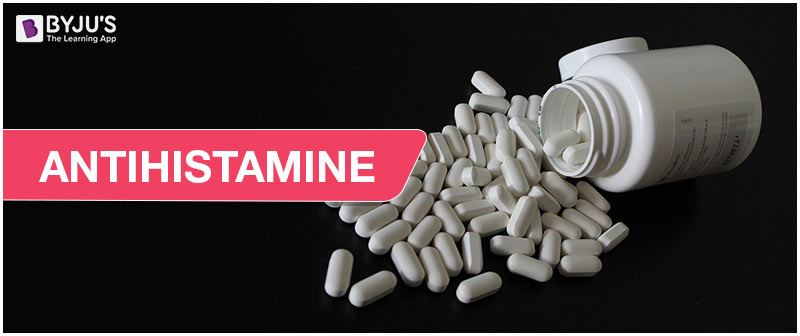What is Antihistamine?
Antihistamine is a class of drugs that inhibit the physiological action of histamines.
Histamine is an organic compound, which is involved in local immune responses and also acts as a neurotransmitter. It is also involved in the inflammatory response and is a mediator of pruritus.
Table of Contents
- Action of antihistamines for the treatment of allergies
- Antihistamine Classification
- Side effects of Antihistamines
- Frequently Asked Questions – FAQs
Histamine is produced by basophils and is found in tissues that are connected nearby. The permeability of white blood cells is increased by histamine and this allows the pathogens to get engaged with the infected tissues.
The action of antihistamines for the treatment of allergies
- When our body comes in contact with components such as pollen, dust mites, pet dander etc, a chemical called histamine is formed that triggers an allergy.
- This allergy causes: swelling of the nose, running eyes, and sometimes even itching in the mouth.
- Antihistamines block the action of histamines and protect us from the allergy. They work against the symptoms of different kinds of allergies, which include hay fever, food allergy, etc.
- But their application is limited as they cannot be used to relieve every kind of symptom.
- If we suffer from nasal congestion, the doctor will advise an intake of decongestants. Some drugs are formed by the combination of antihistamines and decongestants.
- Antihistamines are used in the treatment of any allergy. Brompheniramine (Dimetapp) and terfenadine (Seldane) are synthetic drugs, which act as antihistamines. These drugs actually interfere with the natural action of histamines. They compete with the histamines in order to obtain the binding sites of the receptor, where histamines exert their effect.

Antihistamine Classification
Antihistamines are basically divided into two.
- First generation Antihistamine
H₁ antagonists, also called H₁ blockers, are a class of medications that block the action of histamine at the H₁ receptor, helping to relieve from allergic reaction. - Second generation Antihistamine
- Generally do not cause the sedation and drying seen in first-generation antihistamines
- Do not cross the blood-brain barrier as readily as First Generation compounds
- Lipophobicity
- Large molecular size
- Electrostatic charge
Side Effects of Antihistamines
Antihistamines are harmful in nature, some are comparatively more harmful than others.
- The older groups known as the first generation of antihistamines are more harmful, for example, Benadryl and Chlor-Trimeton. They cause drowsiness particularly.
- On the other hand, the newer generation of antihistamines is comparatively less harmful, for example, Allegra, Clarinex, and Zyrtec. Dry mouth is the main side effect of antihistamines and their use should be avoided as much as possible.
Frequently Asked Questions – FAQs
What is the best antihistamine to take?
Antihistamines such as Claritin and Zyrtec are widely used over-the-counter. Doctors consider them to be safe and efficient allergy therapies. Both are antihistamines of the second generation. These antihistamines are less sedating than first-generation antihistamines.
Are antihistamines anti-inflammatory?
Antihistamines have lately been discovered to have anti-inflammatory effects that go beyond simple histamine receptor inhibition. New research, for example, reveals that these medications decrease the expression of cell adhesion molecules.
How quickly does antihistamine work?
Antihistamine medications usually start working within 30 minutes of taking them and are most effective within 1-2 hours of taking them. Antihistamines are more effective when taken on a regular basis as a preventative measure, rather than merely when symptoms appear.
What fruits are high in histamine?
Strawberries, bananas, pineapple, and pears are examples of citrus fruits. Eggplant, avocado, tomatoes, olives, and beans are examples of vegetables. Cheese, yoghurt, and processed cheese are examples of dairy products.
Does drinking water reduce histamine?
More than 95 percent of excess histamines are removed from the body through the urine, therefore water does help with histamine clearance. Drinking enough water keeps histamine levels safe and healthy, allowing your body to digest them efficiently.
For more information on topics of chemistry like antibiotics, types, and side effects and more, register with BYJU’S.


Comments